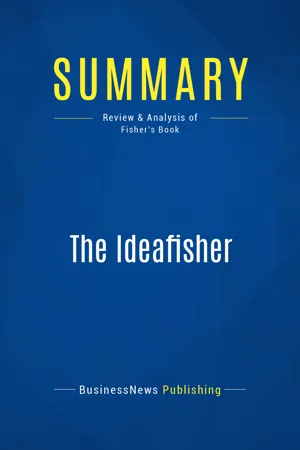![]()
Summary of The IdeaFisher (Marsh Fisher)
PART 1
ASSOCIATIONAL THINKING AND CREATIVITY IN BUSINESS
Main Idea
Associational thinking is the principle that the mind stores information in clusters or packets of associated ideas and other information. Therefore, to think creatively, all a person needs to do is to develop new ways of collecting images and concepts from different groups and combine them together. In other words, creativity lies in forming new relationships between pieces of existing information which have never before been combined that way.
Supporting Ideas
Association thinking was developed in the 17th century by John Locke, an English philosopher.
Prior to that time, thinking was considered to be built around intuition. It was assumed that people took in information through any of the five senses (sight, smell, sound, touch or taste) and stored that information somewhere in the mind. Recalling an idea was then considered to be a random act.
Locke asked why it was people could hear a voice and immediately visualize their friend, or smell smoke and be reminded of a pleasant night spent in front of an open fire. Locke suggested the mind stored concepts in groups of associated concepts, like a family. Locke further suggested knowledge consisted of organizing these concepts according to whatever they had in common.
An American philosopher / psychologist, William James, said:
“The art of remembering is the art of thinking.”
According to James, memories need a clue or a trigger around which associated concepts could be gathered. Once all those concepts were available, the mind could then think, as one concept from the memory will lead to another and so on.
One of the original developers of the concept of Artificial Intelligence, Marvin Minsky, said:
“When our Redness, Touch or Toothache agents send their signals to the brain, each by itself can only say, “I’m here”. The rest of what such signals “mean” to us depends on how they’re linked to all our other agencies. In other words, the “qualities” of signals sent to brains depend only on relationships.”
For example, when you consider an “apple”, it will trigger memories of experiences you’ve had eating apples in the past. Each person’s associations will be highly individualized and unique.
In 1992, the Nuerology and Cognitive Science Departments of Johns Hopkins University confirmed the results of their study of the human mind. They found the brain does store information in hierarchical categories, and that specific brain cell clusters are dedicated to highly focused categories of concepts such as plants, animals and emotions. To date, around 20 such specific brain cell clusters have been identified by researchers.
So, what is the role of the imagination? A person’s imagination has access to all information stored in the brain, as well as an ability to pick images from different groups and combine them to form new concepts which are a combination of other concepts.
Thinking is not merely intuition. It is mental process of connecting two concepts which are not normally associated together.
“The secret of what anything means to us depends on how we’ve connected it to all the other things we know. A thing with just one meaning has scarcely any meaning at all, but well-connected meaning structures let you turn ideas around in your mind to consider alternatives and envision things from many perspectives until you find one that works. And that’s what we mean by thinking.”
– Marvin Minsky
“The connecting is the thinking.”
– John Locke
From this perspective, the...
